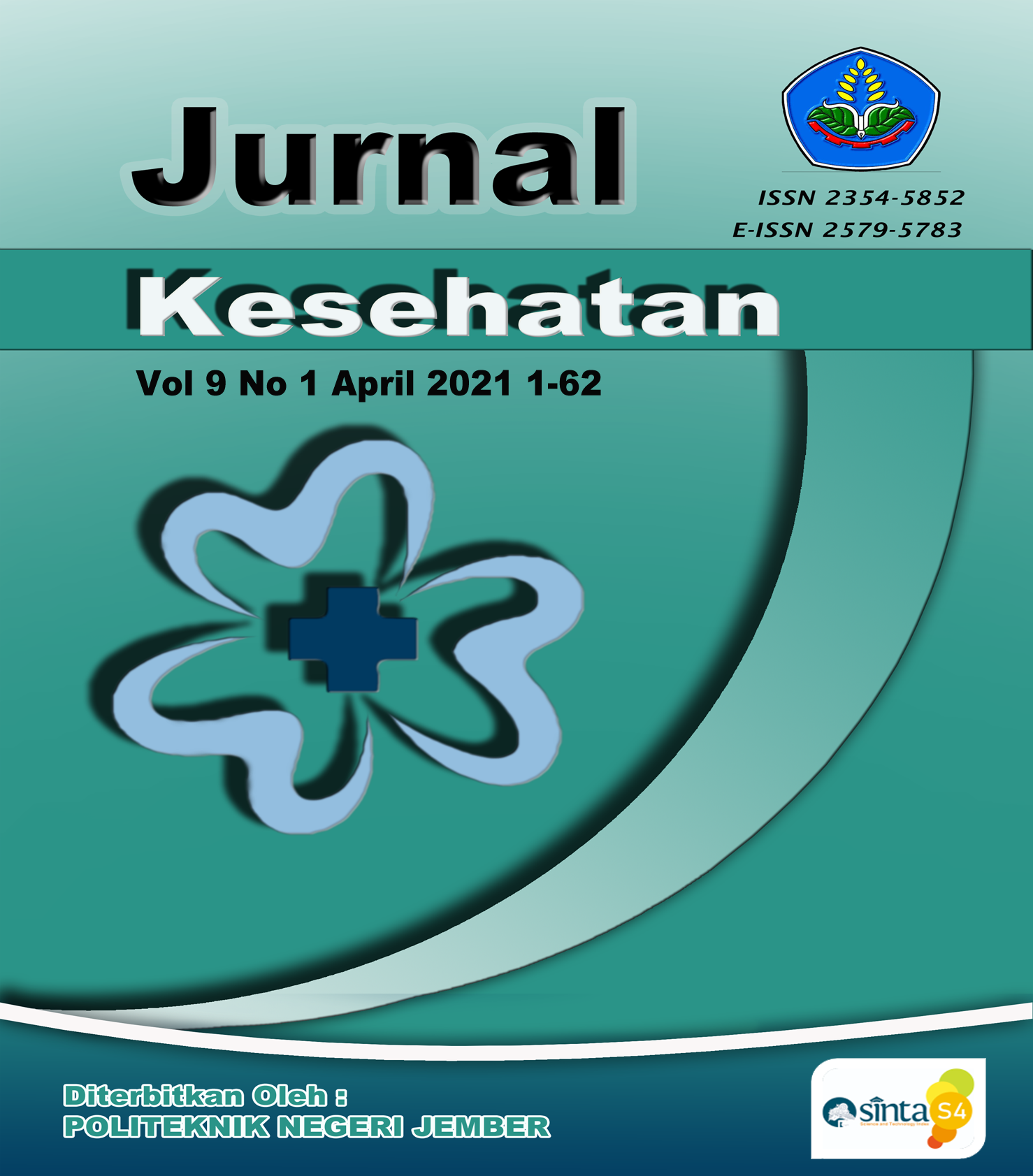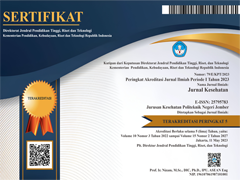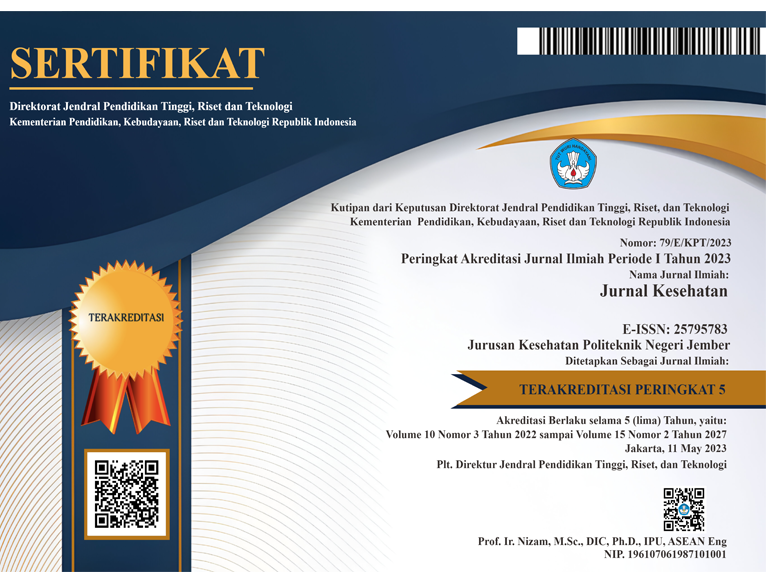
Hubungan Indeks Massa Tubuh dengan Kolesterol, LDL, dan Trigliserida pada Pasien Jantung Koroner di Kota Banda Aceh
DOI:
10.25047/jkes.v9i1.161Downloads
Abstract
Obesity is a form of excessive fat composition in a person's body and allows increased levels of lipids in the blood so it is very risky in patients with coronary heart disease (CHD). The parameter used in identifying obesity as a form of nutritional status in adults is body mass index (BMI). Being overweight is synonymous with several non-communicable diseases, one of which is CHD. The study aimed to measure the relationship of BMI with cholesterol, LDL, and triglyceride in CHD patients in Banda Aceh City. The study used a cross-sectional design, which was conducted at several hospitals in Banda Aceh City with a sample of 28 outpatient CHD patients. Characteristic data collection was carried out by interview using a questionnaire, body weight, height, and BMI data were collected through anthropometric measurements, while lipid profile data (cholesterol, LDL, and triglyceride levels) were collected through laboratory examination of colorimetric chemical methods with UV-VIS spectrophotometer. Data analysis using Pearson Correlation test on CI: 95%. The results showed a significant relationship between BMI with cholesterol levels (p= 0,001) and triglyceride levels (p= 0,027), and had moderate and positive correlation strengths. In contrast, BMI with LDL levels did not show a significant relationship (p= 0,192). Conclusion, BMI has a positive effect on cholesterol and triglyceride levels, but it is not significant in increasing LDL levels in CHD patients in Banda Aceh City. Suggestion, CHD patients need to do a healthy lifestyle and consume balanced food and do physical activities such as running, biking, walking fast routinely.
Keywords: Cardiovascular, cholesterol, LDL, obesity, triglycerides
Keywords:
Cardiovascular, cholesterol, LDL, obesity, triglyceridesReferences
Ades, P. A., Balady, G. J. and Berra, K. (2001) ‘Transforming exercise-based cardiac rehabilitation programs into secondary prevention centers: a national imperative’, Journal of Cardiopulmonary Rehabilitation and Prevention. LWW, 21(5), pp. 263–272.
Balitbangkes (2013) Laporan riskesdas 2013, Jakarta: Badan Penelitian dan Pengembangan Kesehatan. Jakarta.
Candrawati, S. (2011) ‘Hubungan tingkat aktivitas fisik dengan indeks massa tubuh (IMT) Dan Lingkar pinggang mahasiswa’, Jurnal Keperawatan Soedirman, 6(2), pp. 112–118.
Depkes RI (2010) Survei Kesehatan Nasional Tahun 2010. Laporan Data Susenas, Departemen Kesehatan RI. Jakarta, Indonesia.
Ghani, L., Susilawati, M. D. and Novriani, H. (2016) ‘Faktor risiko dominan penyakit jantung koroner di Indonesia’, Buletin Penelitian Kesehatan, 44(3), pp. 153–164.
Harahap, H. et al. (2008) ‘Hubungan Indeks Massa Tubuh, Jenis Kelamin, Usia, Golongan Darah Dan Riwayat Keturunan Dengan Tekanan Darah Pada Pegawai Negeri Di Pekan Baru’, Nutrition and Food Research, 31(2).
Harriman, G. et al. (2016) ‘Acetyl-CoA carboxylase inhibition by ND-630 reduces hepatic steatosis, improves insulin sensitivity, and modulates dyslipidemia in rats’, Proceedings of the National Academy of Sciences. National Acad Sciences, 113(13), pp. E1796–E1805. doi: https://doi.org/10.1073/pnas.1520686113.
Hatmi, Z. N. et al. (2007) ‘Prevalence of coronary artery disease risk factors in Iran: a population based survey’, BMC cardiovascular disorders. Springer, 7(1), p. 32. doi: https://doi.org/10.1186/1471-2261-7-32.
Houghton, D. E. et al. (2017) ‘Hemoglobin Levels, Sex, Race and Coronary Heart Disease Risk in the Reasons for Geographic and Racial Differences in Stroke Study’, Blood. American Society of Hematology, 130(Supplement 1), p. 4737.
Humaera, Z., Sukandar, H. and Rachmayati, S. (2017) ‘Korelasi indeks massa tubuh dengan profil lipid pada masyarakat di Jatinangor tahun 2014’, Jurnal Sistem Kesehatan, 3(1).
Hussain, M. A. et al. (2016) ‘The burden of cardiovascular disease attributable to major modifiable risk factors in Indonesia’, Journal of epidemiology. Japan Epidemiological Association, 26(10), pp. 515–521.
Iskandar, I., Hadi, A. and Alfridsyah, A. (2017) ‘Faktor Risiko Terjadinya Penyakit Jantung Koroner pada Pasien Rumah Sakit Umum Meuraxa Banda Aceh’, AcTion: Aceh Nutrition Journal, 2(1), pp. 32–42. doi: http://dx.doi.org/10.30867/action.v2i1.34.
Krummel, D. A. (2008) ‘Medical nutrition therapy in cardiovascular disease’, Mahan LK, Escott-Stump S, 11th ed. editors. Krause’s food nutrition.
Kumar, L. and Das, A. L. (2018) ‘Assessment of serum lipid profile in patients of coronary artery disease: a case-control study’, International Journal of Contemporary Medical Research, 5(5), pp. 59–62.
Lameshow, S. et al. (1997) Besar Sampel dalam Penelitian Kesehatan. Edited by D. Pramono and H. Kusnanto. Yogyakarta: Gadjah Mada University Press.
Lavie, C. J. et al. (2012) ‘Body composition and survival in stable coronary heart disease: impact of lean mass index and body fat in the “obesity paradox”’, Journal of the American College of Cardiology. Journal of the American College of Cardiology, 60(15), pp. 1374–1380.
Lu, Y. et al. (2014) ‘Metabolic mediators of the effects of body-mass index, overweight, and obesity on coronary heart disease and stroke: a pooled analysis of 97 prospective cohorts with 1,8 million participants.’, Lancet, 383(9921), pp. 970–983. doi: 10.1016/s0140-6736(13)61836-x.
Murti, B. (2010) Desain dan Ukuran Sampel untuk Penelitian Kuantitatif dan Kualitatif di Bidang Kesehatan. Kedua. Yogyakarta: Gadjah Mada University Press.
Puddu, P. E. and Menotti, A. (2018) ‘Lifestyle factors and the impact on lifetime incidence and mortality of coronary heart disease’, in Lifestyle in Heart Health and Disease. Elsevier, pp. 47–61.
Al Rahmad, A. H. (2018) ‘Pengaruh Pemberian Konseling Gizi terhadap Penurunan Kadar Kolesterol Darah’, Jurnal Kesehatan. Online, 9(2), pp. 241–247. doi: 10.26630/jk.v9i2.947.
De Schutter, A. et al. (2013) ‘Correlation and discrepancies between obesity by body mass index and body fat in patients with coronary heart disease’, Journal of cardiopulmonary rehabilitation and prevention. LWW, 33(2), pp. 77–83.
Vlodaver, Z. et al. (2012) Coronary Heart Disease: Clinical, Angiographic, & Pathologic Profiles. Springer Science & Business Media.
Watuseke, A. E., Polii, H. and Wowor, P. M. (2016) ‘Gambaran kadar lipid trigliserida pada pasien usia produktif di Puskesmas Bahu Kecamatan Malalayang Kota Manado periode November 2014–Desember 2014’, eBiomedik, 4(2), pp. 1–5.
WHO (2015) WHO estimates of the global burden of foodborne diseases: foodborne disease burden epidemiology reference group 2007-2015. Geneva, Switzerland: World Health Organization.
WHO (2018) The top 10 causes of death, Newsroom and Fact sheets. Available at: https://www.who.int/en/news-room/fact-sheets/detail/the-top-10-causes-of-death.
Yuliani, F., Oenzil, F. and Iryani, D. (2014) ‘Hubungan berbagai faktor risiko terhadap kejadian penyakit jantung koroner pada penderita diabetes melitus tipe 2’, Jurnal Kesehatan Andalas, 3(1), pp. 1–4.
Yusida, N., Pramonodjati, F. and Wuskawuri, K. (2016) ‘Hubungan Indeks Massa Tubuh dan Rasio Lingkar Pinggang Pinggul terhadap Kadar Kolesterol LDL Pada Mahasiswa Fakultas Ilmu Kesehatan Universitas Setia Budi Surakarta’, Biomedika, 9(2), pp. 1–5.
License
Copyright (c) 2021 Jurnal Kesehatan

This work is licensed under a Creative Commons Attribution-ShareAlike 4.0 International License.
Authors who publish in this journal agree to the following terms:
1. Copyright belongs to the medical journal as a publication
2. The author retains copyright and grants the journal rights to the first publication carried out simultaneously under a Creative Commons Attribution License which allows others to share the work with an acknowledgment of the author's work and initial publication in this journal.
3. Authors may enter into separate additional contractual arrangements for the non-exclusive distribution of the work (eg sending it to an institutional repository or publishing it in a book) with acknowledgment of initial publication in this journal.
4. Authors are permitted and encouraged to post work online (eg in institutional repositories or on their websites) before and during the submission process, as before and larger citations of published work (see Effects of Open Access).
Selengkapnya tentang teks sumber ini













